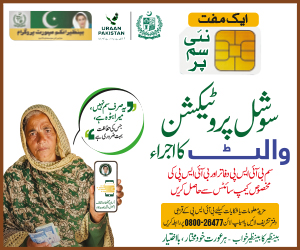
Pakistan at a Humanitarian Crossroads: Integrating Health, Nutrition, and Mental Health & Psychosocial Wellbeing for Recovery
A united effort in health, nutrition, and mental support is vital for Pakistan's flood recovery.
Author: Shiza Hameed – Public Health Nutrition Specialist
Pakistan is grappling with a humanitarian crisis of unprecedented scale after an exceptionally strong monsoon and widespread flash floods beginning 26 June 2025. According to OCHA’s Situation Overview (6 October 2025), the floods have caused 1,037 deaths, 1,067 injuries, and damaged or destroyed over 229,760 houses; more than 2.7 million people have been displaced and essential services including health, nutrition and WASH have been severely disrupted. UNOCHA+1
In Khyber Pakhtunkhwa (KP), roughly 1.57 million people were identified as affected in the RNA, with 604,000 people in urgent need; over 42,000 houses were damaged and more than 150 health facilities recorded damage or service disruption. Nutrition screening in assessed districts reached 16,489 children and 1,118 children were enrolled in treatment for severe acute malnutrition (SAM); mobile MHPSS teams reached 3,126 people — marking early but inadequate coverage against the scale of need. UNICEF+1
Punjab has one of the largest humanitarian burdens: RNAs covering 18 flood-affected districts estimate 4.2 million people affected and 2.8 million displaced, with 161,700 houses damaged and 395 health facilities assessed as damaged (out of 742 surveyed). Nutrition screening has reached 114,011 children, 5,460 children have been treated for SAM to date, and MHPSS mobile teams have reached 3,150 people — while the scale of displacement and facility damage continues to overwhelm local capacity. UNICEF+1
In Sindh, over 2.5 million people are affected and around 1.1 million displaced; RNAs and UNICEF updates report more than 25,000 houses damaged, with nutrition screening and treatment underway (approximately 25,000 children screened and ~1,900 treated for SAM in assessed areas). Urban flooding, severe crop and livestock losses and market disruptions have driven acute food insecurity and high SAM risk in pockets across the province. UNICEF+1
Balochistan faces heavy livelihood and service disruption with an estimated 1 million people affected and 500,000 displaced, approximately 18,000 houses damaged and 90 health facilities impacted. Nutrition outreach reported ~10,000 children screened, with roughly 900 children receiving SAM treatment in assessed areas. Remote districts and broken supply chains complicate rapid scale-up of integrated services. UNICEF+1
Azad Jammu & Kashmir (AJK) remains acutely vulnerable due to landslide-prone terrain and riverine flooding: situational reporting and WHO/OCHA inputs indicate around 450,000 people affected, 150,000 displaced, 12,500 houses damaged and 45 health facilities impacted; nutrition and MHPSS reach is still limited (screening ~5,000 children, SAM treatment ~450, MHPSS ~500 in initial reports). The geography of AJK — mountainous valleys and cut-off communities — exacerbates delays in relief and continuity of services. EMRO+1
In Gilgit-Baltistan (GB), heavy rains and landslides isolated valleys and cut road access; WHO and UNICEF sitreps report roughly 356,000 people affected (including 40,000 displaced), 1,253 houses damaged and 7 health facilities impacted, with nutrition screening around 2,500 children and ~200 treated for SAM; MHPSS mobile outreach has reached several hundred people but is insufficient given isolation and access challenges. EMRO+1
The links between disrupted health services, failing nutrition, and rising psychosocial distress are clear: interruptions to routine immunization, antenatal and delivery services, damage to OTPs and stabilization centres, contaminated water and sanitation, and loss of livelihoods all accelerate wasting, stunting, micronutrient deficiency and mental-health harm. Whose health emergency reporting underscores the risk of diarrhoeal and vector-borne disease surges that compound malnutrition unless WASH and health are restored? EMRO+1
What needs to be done now? Demands an integrated response that treats health, nutrition and MHPSS as one coordinated package rather than separate silos. First, scale up nutrition services nationwide: systematic MUAC and growth monitoring door-to-door and at clinics, rapid expansion of OTPs and stabilization centres, guaranteed supplies of RUTF and therapeutic milks, and universal micronutrient provision for children and pregnant & lactating women. Maternal nutrition and IYCF counselling must be part of every nutrition contact. UNICEF+1
Second, restore and adapt health services to the emergency: repair and re-equip damaged facilities (prioritizing facilities serving largest displaced populations), deploy mobile primary-health teams to cut-off valleys, resume immunization and antenatal care campaigns, and ensure supply-chain corridors for essential medicines and vaccines. Health and nutrition teams should coordinate daily so that screening, referral and treatment happen in one contact. UNOCHA+1
Third, make MHPSS universal within the response: embed psychosocial first aid, child-friendly spaces, caregiver support groups and referral pathways into nutrition and health outreach — especially in displacement sites, schools and OTP/TSFP centres. Mobile MHPSS teams must scale from the current hundreds to reach tens of thousands, with trained community volunteers and integration into primary care for sustained support. UNICEF+1
Fourth, pair WASH with every health-nutrition contact: ensure safe drinking water (water trucking and rapid repair), hygiene kits for women and households, latrine repair, and strong hygiene-promotion to reduce diarrhoeal disease that drives wasting. UNICEF and field sitreps show WASH gaps correlate directly with nutrition deterioration, making these combined actions non-negotiable. UNICEF+1
Fifth, protect and restore livelihoods and food systems: emergency cash and food assistance, seed and livestock support, market rehabilitation and social-protection top-ups prevent families from selling assets or skipping meals — actions that would drive longer-term malnutrition. FAO/WFP and national RNAs recommend linking early recovery interventions to nutrition outcomes. UNOCHA+1
Sixth, surge funding, coordination and preparedness: international donors and national planners must fund integrated packages (health + nutrition + MHPSS + WASH) and pre-position buffer stocks and surge teams for the next shock. OCHA’s support plan outlines relief and early-recovery needs through April 2026 and underscores funding shortfalls that constrain integrated scale-up. UNOCHA+1
The floods of 2025 have exposed the fragility of Pakistan’s systems — but the evidence and RNAs show where to target lifesaving integrated action. If nutrition screening and treatment, health services, water and sanitation, and psychosocial support are delivered together, at scale and without delay, we can avert many preventable deaths, reduce long-term developmental harm for children, and help communities rebuild with resilience. The clock is ticking; integrated action is not optional — it is the only humane and effective route out of this crisis. UNICEF+2UNICEF+2
“In a humanitarian crisis, healing must mean more than survival — it must unite health, nutrition, and mental wellbeing into one act of recovery.” — Shiza Hameed





Comments are closed, but trackbacks and pingbacks are open.